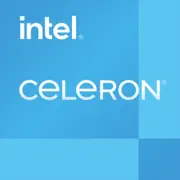Intel Celeron 6305

Intel Celeron 6305: A Budget Processor for Everyday Tasks – Full Review
Architecture and Manufacturing Process: 10nm SuperFin and Modest Capabilities
The Intel Celeron 6305, released as part of the Tiger Lake lineup (11th generation), is positioned as a solution for budget laptops. Its architecture is based on 10nm SuperFin technology, which provides higher energy efficiency compared to previous generations (like Ice Lake). However, the key feature of the Celeron is its minimalist configuration:
- 2 cores and 2 threads: the absence of Hyper-Threading limits multitasking capabilities.
- Clock speeds: base frequency is 1.8 GHz, maximum in turbo mode reaches up to 2.3 GHz. Modest figures even for its category.
- Integrated Intel UHD Graphics for the 11th generation: 48 execution units (EUs), supports 4K@60Hz via HDMI 2.0b or DisplayPort, hardware acceleration for video encoding/decoding (H.265, VP9).
What sets it apart?
The 10nm SuperFin manufacturing process allows for reduced power consumption and improved performance per watt. However, the dual-core architecture is a clear compromise for cost. In comparison, the Core i3-1115G4 (also Tiger Lake) has 2 cores but 4 threads and frequencies up to 4.1 GHz.
Power Consumption and TDP: A Balance Between Coolness and Power
The Celeron 6305 belongs to the category of processors with a TDP of 15W, which is typical for ultrabooks and thin laptops. This means:
- Heat Dissipation: Minimal, allowing for the use of passive cooling or compact coolers.
- Operating Modes: In power-saving mode (for instance, at 7-10W), the processor reduces frequencies, which is critical for battery life.
Practical example: The Lenovo IdeaPad 1 with the Celeron 6305 operates without a fan, making it completely silent, but limits performance under prolonged loads.
Performance: Modest Results in Real Tasks
Scores in Geekbench 6 (Single-Core: 744, Multi-Core: 1236) show that the Celeron 6305 is suitable only for basic scenarios:
- Office Work:
— Google Docs, Microsoft Office — comfortable document handling.
— Opening 10-15 tabs simultaneously in Chrome may cause lag (especially with video in the background).
- Multimedia:
— Playing 4K video (via hardware acceleration) — no problems.
— Photo editing in Lightroom or video editing — extremely slow.
- Gaming:
— CS:GO on low settings — 25-35 FPS at 720p resolution.
— Minecraft (without shaders) — 40-50 FPS. Modern AAA titles — won’t run.
- Turbo Mode:
Under short-term loads (system boot, opening a heavy PDF), the processor briefly speeds up to 2.3 GHz but quickly returns to base frequency due to limited TDP.
Usage Scenarios: Who is the Celeron 6305 Designed For?
This processor is a choice for those who value low price and long battery life over power:
- Students: for lectures, text work, Zoom conferences.
- Seniors: ease of use, low hardware requirements.
- Secondary Device: as a compact laptop for travel.
Not suitable for:
— Gamers.
— Freelancers working with graphics or video.
— Users who frequently run multiple programs simultaneously.
Battery Life: Up to 10 Hours Under Ideal Conditions
Thanks to the 15W TDP and 10nm optimizations, laptops with the Celeron 6305 demonstrate impressive battery life:
- Typical runtime: 8-10 hours at screen brightness of 150 nits with load (web surfing, video).
- Power-saving technologies:
— Intel Speed Shift: dynamic frequency management to minimize latency.
— Adaptix Thermal Framework: intelligent thermal budget distribution.
— The “Battery Saver” mode in Windows reduces performance but extends operation by 20-30%.
Example: The Acer Aspire 3 with a 48W·h battery and Celeron 6305 operates for up to 9 hours in mixed mode.
Comparison with Competitors: Fighting for the Budget Segment
- AMD Athlon Silver 7120U (Zen 2, 2 cores/2 threads, 15W):
— Geekbench 6: 698 (Single), 1281 (Multi).
— Pros: more powerful Radeon 610M graphics.
— Cons: higher laptop prices (starting at $350).
- Apple M1 (in entry-level MacBook Air):
— An indirect competitor due to price ($999), but shows 3-4 times greater performance.
- Intel Celeron N5100 (previous generation, Jasper Lake):
— Geekbench 6: 540 (Single), 1012 (Multi).
— Celeron 6305 is faster by 20-25%, but costs an additional $50–70.
Conclusion: Celeron 6305 is optimal only when the laptop price is below $400. With a budget above $500, it is more advantageous to look for Core i3 or Ryzen 3 options.
Pros and Cons: Who Should Tolerate the Limitations?
Strengths:
- Low laptop prices (starting at $300).
- Cool operation and silence (often fanless).
- Support for modern interfaces: Wi-Fi 6, USB-C with Power Delivery.
Weaknesses:
- Slow multi-threaded performance.
- Not suitable for upgrades: most laptops with Celeron have non-removable RAM and modest SSDs.
- Limited relevance period: by 2025, basic tasks are becoming “heavier.”
Recommendations for Choosing a Laptop: What to Look For?
Devices with the Celeron 6305 are budget ultrabooks and entry-level laptops:
- Optimal models:
— Lenovo IdeaPad 1 15IAU7: 8GB RAM, 256GB SSD, 1080p display — $329.
— HP 15-dw5000: 4GB RAM (expandable), 128GB eMMC — $299.
- What to check before buying:
1. RAM size: at least 8GB.
2. Storage type: only SSD (avoid eMMC).
3. Screen: resolution 1920×1080, or you may find working uncomfortable.
4. Ports: availability of USB-C for charging and HDMI for external monitors.
Final Conclusion: A Niche Solution for the Undemanding
The Intel Celeron 6305 is a processor for those who are not willing to overpay for unused capabilities. This is a choice for:
- Users needing a cheap laptop for internet and documents.
- Devices with long battery life and quiet operation.
Key Benefits:
— Laptop prices starting at $300.
— Modern communication standards and video interfaces.
— Sufficient for basic tasks in 2025.
However, already at the level of intensive use (e.g., working with dual monitors or background antivirus), the Celeron 6305 will show its weaknesses. In such cases, it’s better to add $100–150 and choose a device with Core i3 or Ryzen 3.
Basic
CPU Specifications
Memory Specifications
GPU Specifications
Miscellaneous
Benchmarks
Compared to Other CPU
Share in social media
Or Link To Us
<a href="https://cputronic.com/cpu/intel-celeron-6305" target="_blank">Intel Celeron 6305</a>